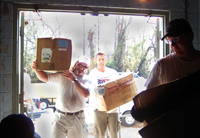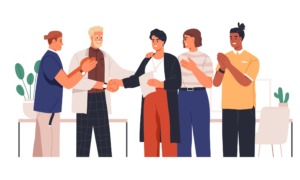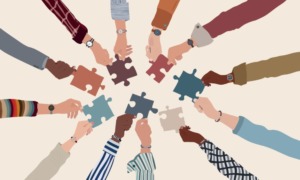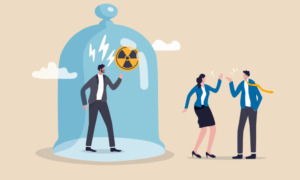The Children’s Coalition for Northeast Louisiana (CCNL) is based in Monroe, safely tucked away from the winds of Hurricane Katrina and the flood waters of Lake Ponchartrain. But Katrina’s aftermath took the agency’s finances by storm.
“It’s stretched our resources to the breaking point,” says Executive Director Lynda Gavioli, whose nonprofit has provided case management and out-of-school activities for thousands of displaced youth at a Red Cross center.
As the weeks since Hurricanes Katrina and Rita grow into months, the sights and sounds of recovery are changing. The whirr of rescue choppers fades into the din of construction; throngs of emergency workers are joined by locals coming home.
For youth-serving organizations, the move from short-term survival to long-term recovery brings both relief and apprehension – about staff, facilities and programming.
In Biloxi, Miss., the local administrative offices for the Boys & Girls Club and Big Brothers Big Sisters of America have already been replaced – by a three-story dockside casino that was swept inland and now sits on the club’s foundation.
In Camp Springs, Miss., the Blossman YMCA is in fine shape – but about 15 employees are homeless, including CEO David Harris. He was preparing late last month to move into a recreational vehicle (RV), one of more than a dozen that are housing YMCA staff around the Gulf Coast.
In Corpus Christi, Texas, the strain of blending two residential centers for emotionally disturbed youth into one facility – after one of the centers was destroyed by Katrina – has contributed to the loss of about 20 staffers since Katrina struck.
“Now that reality is starting to set in, I’m starting to see a lot more people say, ‘I’m going to leave, I can’t do this anymore,’ ” says Scott Lundy, a vice president at Lutheran Social Services of the South (LSS), which runs the two centers.
On the one hand, Lundy and other agency executives say they’ve seen staff and administrators pull together as never before. “I have really been impressed and touched by the level of camaraderie from our other local organizations,” says Clyde McGuire, regional service director for the Boys & Girls Clubs of America in the Gulf Coast. “Boys and Girls Clubs throughout the country said, ‘I can send money. I can send food. I can send staff. We will hire your displaced staff.’ ”
But the task over the coming months and years will be enormous. “Seventy percent of nonprofits are pretty much out of business” for now, says George Penick, president of the Jackson, Miss.-based Foundation for the Mid-South. “Everyone had problems with buildings, meeting October payroll and finding clients.”
For now, much of the recovery work focuses on three areas: stabilizing staff, rebuilding a base of youth to serve, and finding funds to recreate everything from buildings to programs.
Stabilizing Staff
 Days after Katrina hit, youth agencies realized that one of their biggest recovery challenges would be rebuilding their staffs when so many homes had been wiped out. In cases where an agency’s building can be repaired and occupied, “having enough staff to start up is the No. 1 challenge,” says Dan Daly, associate executive director of youth care at Girls and Boys Town. “Many of them had no place to live in anymore.”
Days after Katrina hit, youth agencies realized that one of their biggest recovery challenges would be rebuilding their staffs when so many homes had been wiped out. In cases where an agency’s building can be repaired and occupied, “having enough staff to start up is the No. 1 challenge,” says Dan Daly, associate executive director of youth care at Girls and Boys Town. “Many of them had no place to live in anymore.”
The YMCA of the USA had a great idea: Buy or rent RVs and trailers for staff to live in. But when the organization began looking, every unit in the Gulf Coast seemed to have been taken by government agencies such as the Federal Emergency Management Agency, says Chuck East, the YMCA of the USA’s national director for Gulf Coast relief.
So the national office included RVs on a list of needs that was provided to its affiliates around the country. “People would call in and say, ‘Here’s what we can do. Tell us where you want us to go and we can get it there,’ ” East says.
At least 12 to 15 RVs were donated, he says – most of them the property of YMCA staff who loaned them to other YMCAs, usually driving the vehicles themselves to Louisiana and Mississippi.
Girls and Boys Town, however, had no trailers as it prepared last month to reopen a short-term shelter in New Orleans for homeless and runaway youth. “Our problem was finding enough staff who had personal housing so that we could get back,” Daly says.
The solution: House some of the staff in one of several Girls and Boys Town buildings that weren’t ready to reopen.
At times like these, it’s nice to have a family member with a spare bed – or a few dozen. That’s what the Bethlehem Children’s Center found when it evacuated New Orleans for another residential program run by an LSS agency in Corpus Christi, Texas. But while the Bokenkamp Center had room for Bethlehem’s 40-plus emotionally disturbed youth, the employees had to find places to stay – and they couldn’t afford apartments, furniture and clothes, especially not while they were still paying mortgages on their uninhabitable homes in Louisiana.
So LSS provided housing vouchers for Bethlehem employees at Bokenkamp and later put several of them in nearby apartments.
“I did own a home” in New Orleans, Ora Cutno, executive director of Bethlehem, says with a laugh. It’s still standing, but “my insurance company said, ‘We’re going to have to total your house.’ ” With her agency’s New Orleans campus wiped out as well, she expects her program to be in Corpus Christie for at least the rest of the year, and maybe through next summer.
Finding the Kids
Not only are staff spread out around the South and beyond, so are countless thousands of volunteers, youth and their families.
Perhaps no one is harder hit by the dispersal of kids and volunteer youth workers than Big Brothers Big Sisters of America (BBBSA). For many of the BBBSA agencies in the Gulf Coast area, Hurricanes Katrina and Rita blew away years of work to build thousands of matches between adult mentors and kids. BBBSA estimates that more than 3,400 of its adult/youth matches were “directly impacted” by Hurricane Katrina.
Many of those volunteers and youth are spread throughout the country, and BBBSA has trouble even tracking them down, let alone knowing who will return.
“A lot of our ‘littles’ and some ‘bigs’ were right from New Orleans,” says Joseph Radelet, BBBSA’s vice president of mentoring programs. “There’s a whole section of the city that they’re tearing down.”
For agencies that work under contract with Louisiana’s child welfare and juvenile justice agencies, the scattering of children and families means finding other kids who need help – or stop getting paid. That need has turned the Youth Empowerment Project (YEP) into a mobile juvenile justice agency, with employees at several locations across Texas and Louisiana.
Executive Director Melissa Sawyer now runs her New Orleans-based agency from Austin, Texas – after having evacuated to Houston before Katrina hit, then evacuating from Houston as Hurricane Rita approached, then living with relatives in Michigan, then settling in an Austin hotel. Late last month, she says, she got an apartment on a three-month lease.
YEP helps detained youth integrate back into the community. While Katrina spread YEP’s clients throughout several states, Louisiana’s Office of Youth Development moved all the kids from its juvenile detention facility in New Orleans up to Baton Rouge. That left YEP with just about no one to serve in New Orleans.
The agency is now working with kids who are about to be released from the juvenile facility in Baton Rouge, under a new arrangement with the state, Sawyer says. Two YEP staffers live near the Baton Rouge facility. A YEP social worker is moving back to New Orleans and will use that as a home base. Meanwhile, Sawyer and another staffer will remain in Texas, working in several cities with pre-existing or new YEP clients who fled there.
In places where schools have not reopened, or have only half of their pre-hurricane populations, youth programs that are linked to the schools can do little or nothing to serve kids. “The school systems in New Orleans are sporadically opening,” says Daly at Girls and Boys Town. Many families won’t move back home until the schools are open, leaving the communities – and the local youth programs – with no youth.
The Cash Problem
For long-term recovery, the nonprofit network will need lots of help from the outside, because the financial backbone of its work has been decimated, says Penick of the Foundation for the Mid-South. Nonprofit work “springs from volunteers,” he says, but most of those volunteers are “trying to get their houses back. A lot [of nonprofits] depend on local contributions, and whole groups are bankrupt. They are operated in communities, and they [the communities] have been dispersed.
“All things nonprofits get strength and meaning from, at least for the coming months, are not present.”
Making matters worse, some of the agencies’ funding streams have run dry. “If they’re relying on fees for service,” such as from government agencies, “it will be a long time” until clients return to their towns, Penick says. “If they rely on corporate support, it’s gone.”
Money is flowing to the region from the federal government, foundations and businesses, but relatively little has been earmarked for nonprofits and non-educational youth programs.
The major national youth-serving organizations have set up funds to help their agencies rebuild their buildings, staff and programs, with funding from headquarters, affiliates and the public. BBBSA, for example, contributed $500,000 to its fund and had raised another $60,000 as of late October, Radelet says.
Penick’s foundation is putting some money where his mouth is: He says it will contribute at least $3 million, mostly to help nonprofits recover.
Other funders have also started to move on youth and nonprofit initiatives. The Kellogg Foundation has given a total of $2.9 million to three of its Mississippi grantees for Katrina-related purposes: the Southern regional office of the Children’s Defense Fund, the Mississippi State University Early Childhood Development Institute and the Mississippi Low-Income Child Care Initiative.
The Freddie Mac Foundation used part of its $5 million Katrina commitment to establish the Katrina Fund for Foster Children. The foundation gave $300,000 to the National Foster Parent Association and $700,000 to the Child Welfare League of America (CWLA).
The foster parent association will provide immediate assistance to the organization’s network of parents in the area. “Foster parents are doubled up, scattered throughout the country,” says Renette Oklewicz, manager of foster care and adoption for Freddie Mac.
“Housing is way up there” as a priority for foster families, says Diane Kocer, project manager at the foster parent association. “We’re going to try to put together Habitat [for Humanity]-style volunteer teams from around the country and the local area.”
CWLA will serve as an intermediary, redirecting money to child welfare agencies. Many of the agencies have lost offices, and many of their employees have been displaced, Oklewicz says. “The staff are exhausted, working overtime.”
Once children return to their communities, she says, many agencies will have to ramp up mental health services to deal with post-traumatic stress.
Penick hopes the national foundations “try to find community foundations and other intermediaries that are closer to the ground. It will help them deal both with accountability and finding those groups which would not otherwise have access to national funding.”
When it comes to federal money, one concern is whether funds for hurricane relief will cut into other funding for youth.
“We cannot underscore enough how strongly the entire charitable sector opposes paying for this relief by reducing support for poor people,” Diana Aviv, CEO of Independent Sector, said in testimony before the Senate Finance Committee in late September. “Across-the-board cuts only add to the suffering of those least able to bear them.”
Patrick Boyle can be reached at pboyle@youthtoday.org.
A Dilemma Both Big and Little
The Gulf Coast hurricanes blew big brothers, big sisters and their “littles” all over the country, leaving Big Brothers Big Sisters of America (BBBSA) with a recovery task that might loom larger than fixing buildings.
Before the storms, the BBBSA says, its affiliates were serving 20,900 youth in Alabama, Texas, Louisiana and Mississippi. Now, BBBSA doesn’t know how many of those youth or their adult mentors are still in their communities, much less how many of those who evacuated will return.
As of late last month, for example, the director of the New Orleans program still couldn’t get into her office to retrieve computer tapes that hold names and contact information for the agency’s “bigs” and “littles,” says Joseph Radelet, vice president of mentoring programs.
While some BBBSA agencies appear to be in relatively good shape, others face the prospect of rebuilding essentially their entire stable of adult volunteers and kids to serve.
The national office set up two toll-free numbers and two Web search sites to help mentors, kids and their families re-establish contact, but recognizes that many never will.
BBBSA will use school-based mentoring – an increasing part of its approach in recent years – to help rebuild programs decimated by the hurricanes and to expand programs in areas that have taken in evacuees.
One challenge is to decide how aggressive to be in introducing students to BBBSA. Radelet says the agencies are striving not to “get in the way” as schools struggle to get themselves up and running again or to accommodate scores of new students.
On the other hand, the affiliates don’t want to sit back and do nothing. Radelet says some are providing kids with “bigs for a day” and holding events in schools and community centers to introduce youths and their parents to BBBSA.
YouthBuild Sets Out To Rebuild a Community
Hundreds of youth would descend on North Gulfport, Miss., with hammers, saws and lumber to build up to 300 homes, under a plan announced by YouthBuild USA.
About 500 young people in the federally funded program would rotate in and out of the Gulf Coast community, which was devastated by Hurricanes Katrina and Rita, said YouthBuild USA President Dorothy Stoneman.
YouthBuild USA provides training, coordination and advocacy for Youthbuild programs, which run job training and other services for 16- to 24-year-olds youth as they work toward high school diplomas or GEDs.
The northern section of the town of Gulfport was chosen because of the need, the reception from local officials and the availability of short-term housing for the youth and staff, Stoneman said. She said the North Carolina Baptist Men will house the youths in a local armory.
YouthBuild USA will seek government and other funding for the project, which has no start date, Stoneman said. She envisions up to 50 Youthbuild members in the town at any given time.































